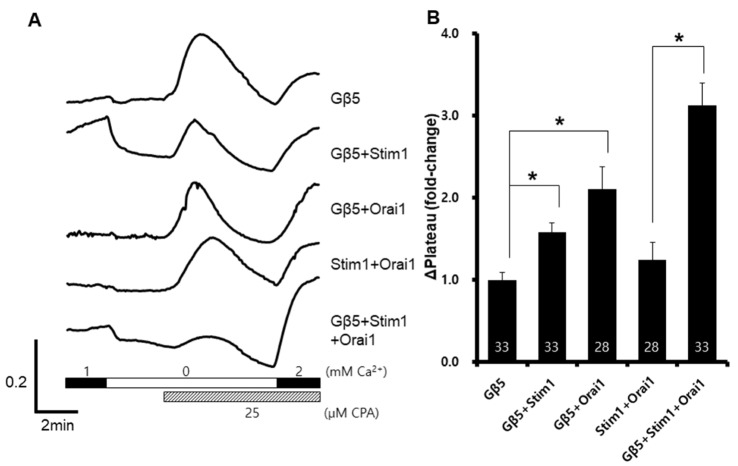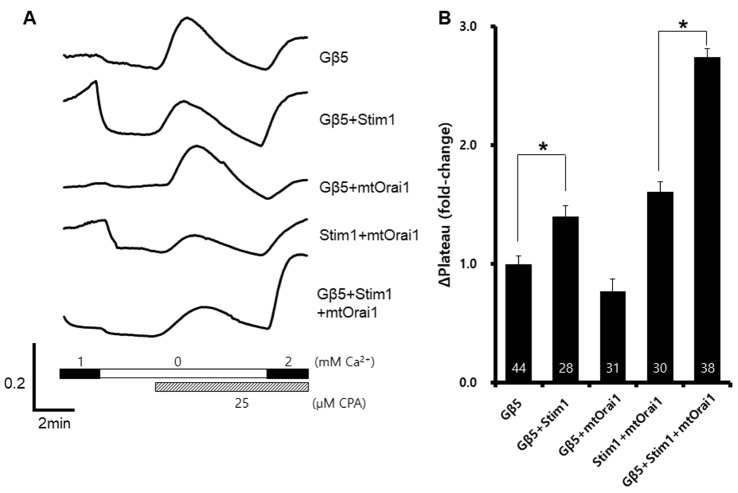1. Logothetis DE, Kurachi Y, Galper J, Neer EJ, Clapham DE. The beta gamma subunits of GTP-binding proteins activate the muscarinic K
+ channel in heart. Nature. 1987; 325:321–326. PMID:
2433589.
2. Dupré DJ, Robitaille M, Rebois RV, Hébert TE. The role of Gbetagamma subunits in the organization, assembly, and function of GPCR signaling complexes. Annu Rev Pharmacol Toxicol. 2009; 49:31–56. PMID:
18834311.
3. Smrcka AV. G protein βγ subunits: central mediators of G protein-coupled receptor signaling. Cell Mol Life Sci. 2008; 65:2191–2214. PMID:
18488142.

4. Kisselev O, Ermolaeva M, Gautam N. Efficient interaction with a receptor requires a specific type of prenyl group on the G protein gamma subunit. J Biol Chem. 1995; 270:25356–25358. PMID:
7592699.
5. Macrez-Leprêtre N, Kalkbrenner F, Morel JL, Schultz G, Mironneau J. G protein heterotrimer Galpha13beta1gamma3 couples the angiotensin AT1A receptor to increases in cytoplasmic Ca
2+ in rat portal vein myocytes. J Biol Chem. 1997; 272:10095–10102. PMID:
9092554.
6. Lodder EM, De Nittis P, Koopman CD, Wiszniewski W, Moura de Souza CF, Lahrouchi N, Guex N, Napolioni V, Tessadori F, Beekman L, Nannenberg EA, Boualla L, Blom NA, de Graaff W, Kamermans M, Cocciadiferro D, Malerba N, Mandriani B, Akdemir ZHC, Fish RJ, Eldomery MK, Ratbi I, Wilde AAM, de Boer T, Simonds WF, Neerman-Arbez M, Sutton VR, Kok F, Lupski JR, Reymond A, Bezzina CR, Bakkers J, Merla G. GNB5 mutations cause an autosomal-recessive multisystem syndrome with sinus bradycardia and cognitive disability. Am J Hum Genet. 2016; 99:704–710. PMID:
27523599.

7. Shamseldin HE, Masuho I, Alenizi A, Alyamani S, Patil DN, Ibrahim N, Martemyanov KA, Alkuraya FS. GNB5 mutation causes a novel neuropsychiatric disorder featuring attention deficit hyperactivity disorder, severely impaired language development and normal cognition. Genome Biol. 2016; 17:195. PMID:
27677260.

8. Xie K, Allen KL, Kourrich S, Colón-Saez J, Thomas MJ, Wickman K, Martemyanov KA. Gbeta5 recruits R7 RGS proteins to GIRK channels to regulate the timing of neuronal inhibitory signaling. Nat Neurosci. 2010; 13:661–663. PMID:
20453851.
9. Xie K, Ge S, Collins VE, Haynes CL, Renner KJ, Meisel RL, Lujan R, Martemyanov KA. Gβ5-RGS complexes are gatekeepers of hyper-activity involved in control of multiple neurotransmitter systems. Psychopharmacology (Berl). 2012; 219:823–834. PMID:
21766168.

10. Collins HE, Zhu-Mauldin X, Marchase RB, Chatham JC. STIM1/Orai1-mediated SOCE: current perspectives and potential roles in cardiac function and pathology. Am J Physiol Heart Circ Physiol. 2013; 305:H446–H458. PMID:
23792674.

11. Kar P, Parekh A. STIM proteins, Orai1 and gene expression. Channels (Austin). 2013; 7:374–378. PMID:
23765192.

12. Ruhle B, Trebak M. Emerging roles for native Orai Ca
2+ channels in cardiovascular disease. Curr Top Membr. 2013; 71:209–235. PMID:
23890117.
13. Shaikh S, Troncoso R, Criollo A, Bravo-Sagua R, García L, Morselli E, Cifuentes M, Quest AF, Hill JA, Lavandero S. Regulation of cardiomyocyte autophagy by calcium. Am J Physiol Endocrinol Metab. 2016; 310:E587–E596. PMID:
26884385.

14. Russell VA, Sagvolden T, Johansen EB. Animal models of attention-deficit hyperactivity disorder. Behav Brain Funct. 2005; 1:9. PMID:
16022733.

15. Lehohla M, Kellaway L, Russell VA. NMDA receptor function in the prefrontal cortex of a rat model for attention-deficit hyperactivity disorder. Metab Brain Dis. 2004; 19:35–42. PMID:
15214504.

16. Lehohla M, Russell V, Kellaway L. NMDA-stimulated Ca
2+ uptake into barrel cortex slices of spontaneously hypertensive rats. Metab Brain Dis. 2001; 16:133–141. PMID:
11769326.
17. Horn JL, Janicki PK, Franks JJ. Diminished brain synaptic plasma membrane Ca
2+-ATPase activity in spontaneously hypertensive rats: association with reduced anesthetic requirements. Life Sci. 1995; 56:PL427–PL432. PMID:
7746091.
18. Liao Y, Erxleben C, Abramowitz J, Flockerzi V, Zhu MX, Armstrong DL, Birnbaumer L. Functional interactions among Orai1, TRPCs, and STIM1 suggest a STIM-regulated heteromeric Orai/TRPC model for SOCE/Icrac channels. Proc Natl Acad Sci U S A. 2008; 105:2895–2900. PMID:
18287061.

19. Lee KP, Yuan JP, Hong JH, So I, Worley PF, Muallem S. An endoplasmic reticulum/plasma membrane junction: STIM1/Orai1/TRPCs. FEBS Lett. 2010; 584:2022–2027. PMID:
19944100.

20. Liou J, Kim ML, Heo WD, Jones JT, Myers JW, Ferrell JE Jr, Meyer T. STIM is a Ca
2+ sensor essential for Ca
2+-store-depletion-triggered Ca
2+ influx. Curr Biol. 2005; 15:1235–1241. PMID:
16005298.
21. Huang GN, Zeng W, Kim JY, Yuan JP, Han L, Muallem S, Worley PF. STIM1 carboxyl-terminus activates native SOC, I
crac and TRPC1 channels. Nat Cell Biol. 2006; 8:1003–1010. PMID:
16906149.
22. Hogan PG, Rao A. Store-operated calcium entry: Mechanisms and modulation. Biochem Biophys Res Commun. 2015; 460:40–49. PMID:
25998732.

23. Nieto Gutierrez A, McDonald PH. GPCRs: Emerging anti-cancer drug targets. Cell Signal. 2018; 41:65–74. PMID:
28931490.

24. Berridge MJ. Inositol trisphosphate and calcium signalling mechanisms. Biochim Biophys Acta. 2009; 1793:933–940. PMID:
19010359.

25. Myung CS, Garrison JC. Role of C-terminal domains of the G protein beta subunit in the activation of effectors. Proc Natl Acad Sci U S A. 2000; 97:9311–9316. PMID:
10922079.

26. Rebres RA, Roach TI, Fraser ID, Philip F, Moon C, Lin KM, Liu J, Santat L, Cheadle L, Ross EM, Simon MI, Seaman WE. Synergistic Ca
2+ responses by Gai- and Gaq-coupled G-protein-coupled receptors require a single PLCb isoform that is sensitive to both Gβγ and Gαq. J Biol Chem. 2011; 286:942–951. PMID:
21036901.
27. Zeng W, Mak DO, Li Q, Shin DM, Foskett JK, Muallem S. A new mode of Ca
2+ signaling by G protein-coupled receptors: gating of IP
3 receptor Ca
2+ release channels by Gβγ. Curr Biol. 2003; 13:872–876. PMID:
12747838.
28. Schindl R, Muik M, Fahrner M, Derler I, Fritsch R, Bergsmann J, Romanin C. Recent progress on STIM1 domains controlling Orai activation. Cell Calcium. 2009; 46:227–232. PMID:
19733393.

29. Yuan JP, Zeng W, Dorwart MR, Choi YJ, Worley PF, Muallem S. SOAR and the polybasic STIM1 domains gate and regulate Orai channels. Nat Cell Biol. 2009; 11:337–343. PMID:
19182790.

30. Sondek J, Bohm A, Lambright DG, Hamm HE, Sigler PB. Crystal structure of a G-protein beta gamma dimer at 2.1A resolution. Nature. 1996; 379:369–374. PMID:
8552196.
31. Cao X, Choi S, Maléth JJ, Park S, Ahuja M, Muallem S. The ER/PM microdomain, PI(4,5)P2 and the regulation of STIM1-Orai1 channel function. Cell Calcium. 2015; 58:342–348. PMID:
25843208.

32. Jing J, He L, Sun A, Quintana A, Ding Y, Ma G, Tan P, Liang X, Zheng X, Chen L, Shi X, Zhang SL, Zhong L, Huang Y, Dong MQ, Walker CL, Hogan PG, Wang Y, Zhou Y. Proteomic mapping of ER-PM junctions identifies STIMATE as a regulator of Ca
2+ influx. Nat Cell Biol. 2015; 17:1339–1347. PMID:
26322679.
33. Vig M, Peinelt C, Beck A, Koomoa DL, Rabah D, Koblan-Huberson M, Kraft S, Turner H, Fleig A, Penner R, Kinet JP. CRACM1 is a plasma membrane protein essential for store-operated Ca
2+ entry. Science. 2006; 312:1220–1223. PMID:
16645049.
34. Shin DM, Son A, Park S, Kim MS, Ahuja M, Muallem S. The TRPCs, Orais and STIMs in ER/PM Junctions. Adv Exp Med Biol. 2016; 898:47–66. PMID:
27161224.

35. Kim MS, Lee KP, Yang D, Shin DM, Abramowitz J, Kiyonaka S, Birnbaumer L, Mori Y, Muallem S. Genetic and pharmacologic inhibition of the Ca
2+ influx channel TRPC3 protects secretory epithelia from Ca
2+-dependent toxicity. Gastroenterology. 2011; 140:2107–2115. 2115.e1–2115.e4. PMID:
21354153.








 PDF
PDF ePub
ePub Citation
Citation Print
Print


 XML Download
XML Download